Fed up with high electricity bills due to outdated lighting? You want to save money and energy, but the confusion around different technologies keeps you from making a confident and cost-effective choice.
LED downlights are significantly more energy-efficient because they convert a much higher percentage of electricity into light, not heat. Unlike CFLs and halogens, which waste over 80% of energy as heat, LEDs use their power primarily for illumination, drastically cutting energy consumption and costs.
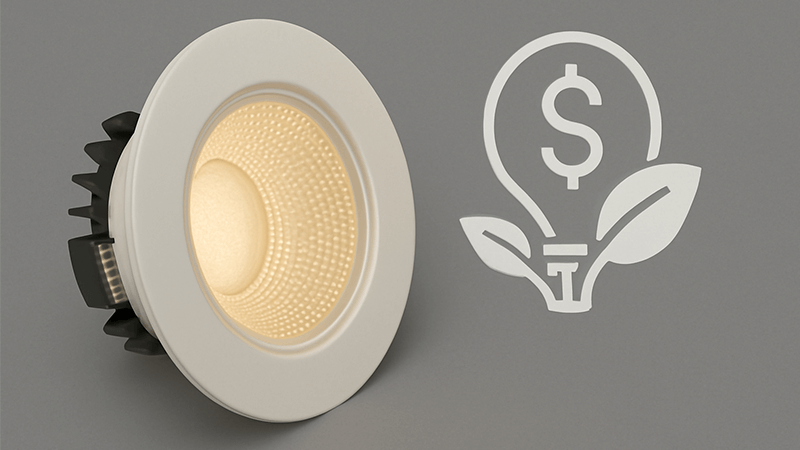
I've spent my career in the lighting industry, from working on the factory floor to founding my own company, iPHD. I’ve seen the technology evolve firsthand. Many people, like my client Shaz, a purchasing manager in the UAE, often ask me about the real-world differences between lighting types. They want to know if the switch to LED is truly worth it. So, let’s break down the common questions and get to the bottom of why LEDs are the clear winner for efficiency.
Are LED lights more efficient than CFL?
Worried about the mercury in CFLs and their slow warm-up time? You want a safer, instantly bright light but aren't sure if LEDs are a big enough improvement to justify replacing them.
Yes, LED lights are more efficient than CFLs. LEDs convert more electricity into light, last up to three times longer, and contain no toxic mercury. They also provide instant, full brightness, unlike CFLs which need time to warm up to their full potential.
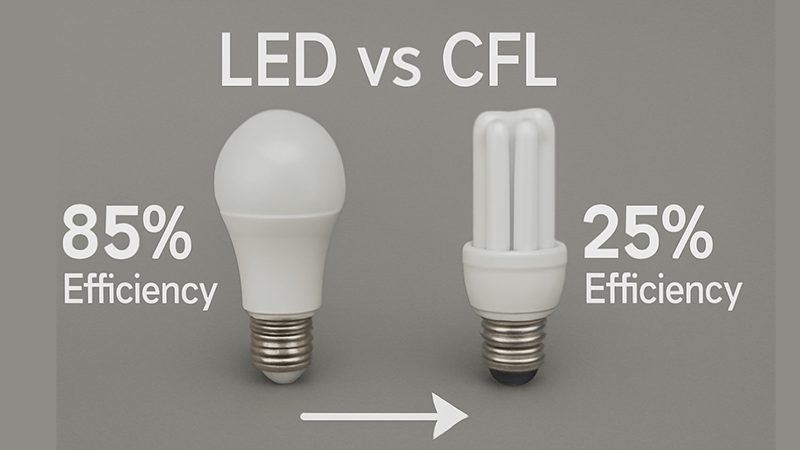
I remember in the early 2000s when everyone thought CFLs were the future of energy-saving lighting. They were a decent step up from old-fashioned incandescent bulbs. But technology moves fast. When my clients ask if LEDs are really better than the CFLs they already have installed, I tell them the difference is night and day. It’s not just a small improvement; it's a complete upgrade. Let's look at the key factors that set them apart. The science behind it is simple but powerful.
How LEDs Outperform CFLs
The core difference is in how they produce light. CFLs1 work by passing an electric current through a tube with mercury2 vapor. This creates ultraviolet (UV) light that hits a phosphor coating to make visible light. This process is not very efficient and has real drawbacks. LEDs, on the other hand, use a semiconductor to turn electricity directly into light. This is a much more direct and efficient method. This fundamental difference in technology leads to several key advantages for LEDs in any project.
Here is a simple comparison:
| Feature | CFL (Compact Fluorescent) | LED (Light-Emitting Diode) |
|---|---|---|
| Energy Efficiency | Uses 75% less energy than incandescent | Uses 80-90% less energy than incandescent |
| Lifespan | 8,000 - 10,000 hours | 25,000 - 50,000+ hours |
| Warm-up Time | Takes 30 seconds to 3 minutes to reach full brightness | Instant-on at 100% brightness |
| Environmental Impact | Contains toxic mercury, requires special disposal | No mercury, fully recyclable |
| Durability | Made of glass, very fragile | Made of solid-state components3, very durable |
For a purchasing manager like Shaz, these numbers are critical. A longer lifespan4 means fewer replacements and lower maintenance costs. Instant brightness is essential for commercial spaces5 where you can't wait for lights to warm up. And the absence of mercury makes disposal easier and safer for everyone.
Is LED more energy-efficient than halogen?
You love the warm, cozy light from your halogen bulbs. But the high heat they produce and the frequent replacements are a constant frustration, making you question if the ambiance is worth it.
Absolutely. An LED is vastly more energy-efficient6 than a halogen bulb. Halogens are incredibly wasteful, turning about 90% of electricity into heat and only 10% into light. LEDs reverse this, using most of their energy for light, which cuts energy use by up to 90%.
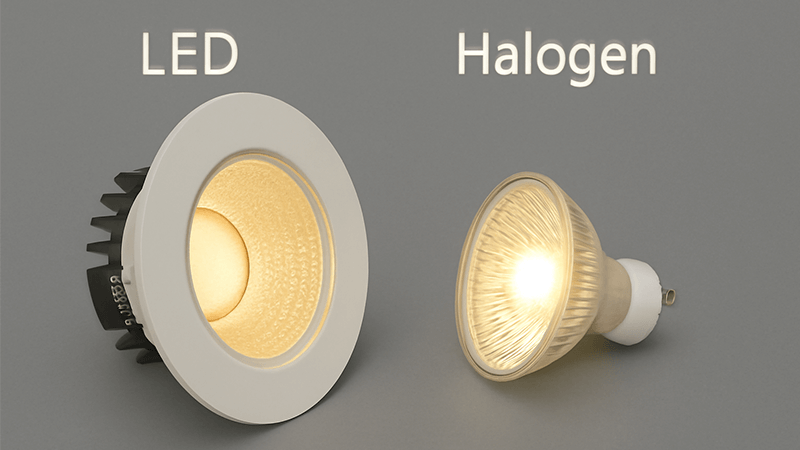
I often hear people say they miss the "feel" of halogen light. A client once told me, "Michael, the items under my old halogen lights just looked so warm and rich. The first LEDs I tried made everything look pale and cold." This is a common feeling. He also mentioned that the halogen bulbs felt warm to the touch, which seemed powerful. But that "warmth" is actually a sign of massive energy waste. Let's dig deeper into why the cool-running LED is the far more powerful and efficient choice in the long run.
The Truth About Halogen's "Warmth"
That classic halogen light comes from a simple but outdated technology. It's essentially an advanced version of an incandescent bulb, where a tungsten filament is heated until it glows brightly. This process is more like an electric heater than a modern light source.
Heat vs. Light
The biggest misunderstanding is about the heat. Halogen bulbs get extremely hot because over 90% of the electricity they consume is converted directly into infrared radiation, or heat. Only a tiny fraction, less than 10%, actually becomes visible light. That heat not only wastes a huge amount of energy but also poses a safety risk and can damage fixtures or surrounding materials over time.
LEDs work on a completely different principle called electroluminescence. They generate very little heat in the light beam itself. The heat they do produce comes from the driver and internal electronics, and it is carefully managed by a heat sink. This is why you can touch an LED bulb that has been on for hours. This superior thermal management is the secret to their long life and stable performance.
Here’s how they stack up in a typical commercial setting:
| Metric | Halogen Downlight (50W) | LED Downlight (7W) |
|---|---|---|
| Power Consumption | 50 Watts | 7 Watts |
| Energy Wasted as Heat | ~45 Watts (90%) | ~1.5 Watts (20%) |
| Light Output (Lumens) | ~600 lm | ~600 lm |
| Lifespan | 2,000 hours | 50,000 hours |
| Number of Replacements | 25 bulbs | 1 bulb |
For a business, switching from halogen to LED means your electricity bill for lighting could drop by nearly 90%. Plus, you avoid the cost and labor of replacing bulbs 25 times. The "warm" feeling of a halogen bulb is actually the feeling of your money being burned away.
Why is LED lighting more energy-efficient?
You know LEDs save energy, but the science seems complex. You want to understand why they are better, not just that they are, so you can confidently explain your purchasing decisions.
LED lighting is more energy-efficient due to its superior "luminous efficacy." It excels at converting electricity directly into visible light through a semiconductor, wasting very little energy as heat. Older technologies like halogen and CFLs are inherently inefficient, losing most of their energy to heat.
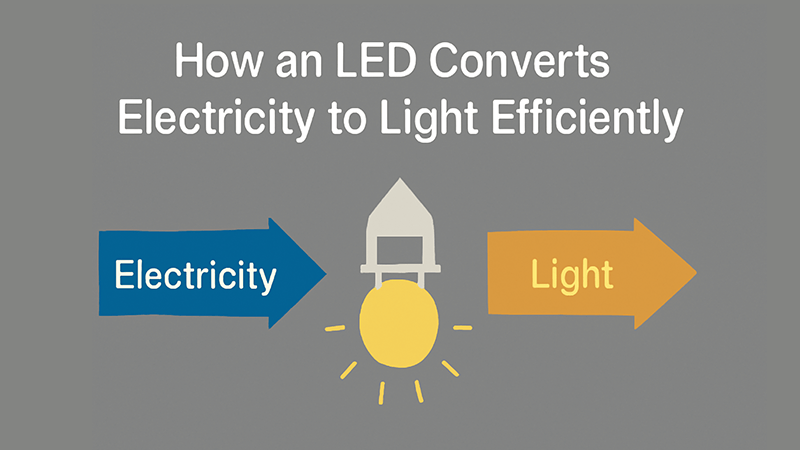
To really grasp why LEDs are the top choice, you have to look at the technology itself. Think of it like comparing a modern electric car to an old gas-guzzler. Both will get you from A to B, but how they use energy is completely different. The gas car loses a ton of energy to heat and friction, while the electric car's motor is incredibly efficient at turning power into motion. Lighting technology has gone through a similar revolution.
Understanding Luminous Efficacy
The key term here is “luminous efficacy7,” which is measured in lumens per watt (lm/W). This metric tells you how much visible light (lumens) a bulb produces for every watt of electricity it consumes. A higher number means a more efficient light source.
A Tale of Three Technologies
Let's break down how the technologies differ in their energy conversion process. It’s the core reason for the massive efficiency gap.
-
Halogen/Incandescent: This is a thermal radiator. You heat a wire until it glows. It works, but it's like boiling a whole kettle of water just to warm your hands. The main output is heat, with light being a minor byproduct. This results in a very low luminous efficacy, typically around 12-18 lm/W.
-
CFL (Fluorescent): This is a gas-discharge lamp. Electricity excites mercury gas, which produces UV light. This invisible UV light then hits a phosphor coating, which in turn glows to create visible light. It's a two-step process with energy losses at each stage. It's better than halogen, but still not great, with an efficacy of about 50-70 lm/W.
-
LED (Light-Emitting Diode): This is a solid-state device. Electricity is passed through a semiconductor material, which stimulates electrons to release energy in the form of photons—or visible light. This is a direct, one-step conversion of electricity to light. It is highly efficient, with modern LEDs easily achieving 90-150 lm/W and even higher in laboratory settings.
Here is a quick reference table:
| Technology | Conversion Process | Main Energy Output | Typical Efficacy (lm/W) |
|---|---|---|---|
| Halogen | Heating a filament | Heat | 12-18 |
| CFL | Exciting gas to create UV light | Heat & UV | 50-70 |
| LED | Passing current through a semiconductor | Light | 90-150+ |
This shows that LEDs aren't just a small step forward; they are based on a fundamentally more efficient way of creating light.
Are LED downlights better than halogen?
You're tempted to switch to LEDs for the energy savings8. But you worry they won't dim properly or match the beautiful color rendering9 of your halogens10, making you hesitate to invest.
Yes, modern LED downlights are better than halogen in almost every way. They offer huge energy savings, a much longer lifespan, and superior safety. Plus, current technology provides excellent dimming11 and high color rendering options that can match or even exceed halogen performance.
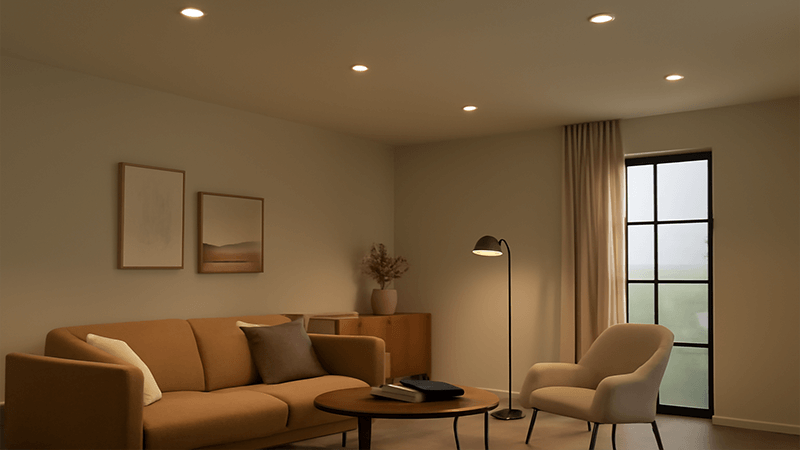
As a manufacturer, I've had to tackle these concerns head-on. Many purchasing managers, including Shaz in the UAE, have told me that their main fears about switching to LED are performance-related, not just cost. They worry about compatibility with existing systems and whether the quality of light will be good enough for high-end projects. One of the biggest myths I have to bust is that LEDs are "cheap and bad." Someone might see a halogen for a few dollars and an LED for much more and think the halogen is a better value. Let's break down these common myths with today's facts.
Myth 1: LEDs Can't Match Halogen's Color Quality
This was true of early LEDs, which could look cold and sterile. People fondly remember the warm, rich tones from halogen bulbs. However, modern LEDs have solved this completely. We use the Color Rendering Index (CRI) to measure how accurately a light source shows an object's true colors. Halogen is near-perfect at 100 CRI. But today's high-quality LEDs consistently offer a CRI of 90, 95, or even 98, which is virtually indistinguishable from halogen to the human eye. We can also produce LEDs in a wide range of color temperatures, from very warm (2700K) to cool daylight (5000K), perfectly matching the "cozy" feel of halogen.
Myth 2: LEDs Don't Dim Well
This is another outdated concern. Early LEDs did flicker or buzz when connected to old TRIAC dimmers designed for halogens. But the industry has adapted. Now, you can find a huge selection of LED downlights12 and drivers that are specifically designed to be compatible with TRIAC dimmers, offering smooth, flicker-free dimming down to very low levels. You can get the same seamless dimming you love from halogens.
Myth 3: LEDs are More Expensive
Looking only at the upfront price is a mistake. A halogen bulb is cheap, but its total cost of ownership is very high. An LED downlight costs more initially, but it saves you much more money over its lifespan.
Here's a simple lifetime cost example for one downlight:
| Cost Factor | Halogen (50W, 2,000 hrs) | LED (7W, 50,000 hrs) |
|---|---|---|
| Initial Bulb Cost | $3 x 25 bulbs = $75 | $15 x 1 bulb = $15 |
| Energy Cost (50k hrs) | $500 | $70 |
| Total Lifetime Cost | $575 | $85 |
(Energy cost estimated at $0.20/kWh)
When you multiply these savings across a whole project—a hotel, an office building, or a retail store—the financial benefit is massive. The initial investment in LEDs pays for itself very quickly.
Conclusion
Switching to LED downlights is a smart decision. They are far more energy-efficient, last longer, and offer excellent light quality, making them the best choice over outdated halogen and CFL fixtures.
Understand the drawbacks of CFLs and why LEDs are a better choice. ↩
Learn about the environmental concerns associated with mercury in CFL bulbs. ↩
Learn about the technology behind LEDs and its advantages over traditional bulbs. ↩
Discover the lifespan differences between LED, CFL, and halogen bulbs. ↩
Discover why LED lighting is ideal for commercial applications. ↩
Learn how energy-efficient lighting can significantly reduce your electricity bills. ↩
Get insights into luminous efficacy and why it matters for energy-efficient lighting. ↩
Discover the potential energy savings when switching to LED lighting. ↩
Explore how color rendering affects the quality of light in different bulbs. ↩
Discover the inefficiencies of halogen bulbs and the benefits of switching to LEDs. ↩
Find out if modern LEDs can provide the same dimming capabilities as halogens. ↩
Explore the advantages of LED downlights for energy efficiency and cost savings. ↩

